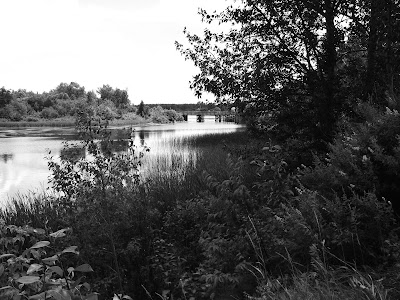I
an Macdonald, retired head of the department of architecture and now professor emeritus at the University Of Manitoba, looks at the cultural heritage of Chapleau with a vivid contrast between the Chapleau Peace-Unity Park for which he gives high praise, and the deterioration of CPR Locomotive 5433 in the Centennial Park. He also suggests other river related historical sites worthy of development as part of Chapleau' s cultural heritage.
 |
| Cedar Street bridge from Peace-Unity park Michael McMullen |
Although Ian has not lived in Chapleau for many years, he maintains an abiding positive interest in the community. He agreed to do two columns on his thoughts about maintaining and improving Chapleau's cultural heritage, after our visit home this year for the official launch of 'The Chapleau Boys Go To War'. Ian was a contributor to the book. We extend our thanks to Michael McMullen for his always valuable insights and assistance. MJM
By Ian MacdonaldOn my most recent visit to Chapleau, I had an opportunity to visit Chapleau’s Peace Park that so effectively celebrates the picturesque landscape of the Nebskwashi River . This is a significant landscape which is part of the natural heritage of Chapleau and the community deserves high praise for creation of this special place
I
The Peace Park is part of the overall cultural heritage of the community which includes buildings, artifacts, books, art and language One should be reminded that Chapleau has been in existence long enough to actually have developed a distinctive cultural heritage unlike some of the more modern Northern Ontario post-war pulp and paper communities like Marathon and Terrace Bay.
 |
| Ojibway workers at HBC sub-post CP Corporate Archives |
Other river related historical sites worthy of development include the site of the Hudson’s Bay Company sub-post on the east bank of the Nebskwashi River built in 1884 and the original canoe landing on the Kebsquasheshing River immediately north of the Civic Centre where meetings associated with the establishment of Treaty Nine ( James Bay Treaty ) were held in 1905.
 |
| Treaty Nine negotiations at Chapleau 1905 National Archives |
Cultural heritage, unlike forgettable and trendy brands and gimmicks is not conjured up in some consultant’s office. You don’t have to hire a Toronto spin doctor to invent it as it exists right where you live and breathe. It differs from symbols like Wawa’s big goose or Kenora’s Husky the Muskie which, as interesting objects, may catch your eye momentarily but really don’t provide any insight of the life and times of the community itself .
 |
| Locomotive 5433 when in active service Ian Macdonald collection |
The CPR steam locomotive in Centennial (Station) Park, for instance, wasn’t the figment of someone’s imagination. This locomotive type was the last generation of steam locomotives designed and built in Canada by the CPR and is closely associated with Chapleau as It was the dominant locomotive type on the Schreiber Division before dieselization. It was thus an authentic and integral part of Chapleau life, operated and maintained by the parents and grandparents of many Chapleau descendants, and a most appropriate symbol of the steam era. Chapleau is lucky to have it
Tourists and long-time residents are able to witness the aesthetic and cultural history of an area through showcasing heritage. For many of my generation, locomotive 5433 validates memories of growing up in Chapleau. In my case, for instance, it provokes memories of my first trial trip as a fireman on a similar locomotive. Younger generations who were born long after steam power disappeared will have a much different association specific to their own experience.
 |
| CPR running board paint guidelines |
Attention to detail is an essential aspect of historic preservation whether it is art, artifact or building. The unfortunate deterioration of Locomotive 5433 since it was positioned in the park some fifty years ago heavily diminishes its value and authenticity as a historical milestone. Accurate replication of lettering style, size, spacing and colour is absolutely essential as it was strictly regulated by the CPR and is specific to this locomotive type. We have made this information available to the community from time to time at no cost, only to have the offer rejected without explanation. This sort of attitude naturally causes concern that little or no value may be assigned to cultural heritage by those shaping strategies for future development.
 |
| Chapleau Public School demolition Sept 2014 Doug Greig |
The recent tragic demolition of the Chapleau Public School illustrates how vulnerable our heritage buildings and sites are. The Chapleau Peace-Unity Park provides encouragement and hope, while, unfortunately, the decaying Locomotive 5433 leaves the opposite impression.
The next article will describe some restoration projects completed in communities the same size as Chapleau and even smaller. Each of these examples required a strategic plan for fundraising and economic sustainability and had the support of enthusiastic and dedicated citizen groups. These are the critical ingredients for success .
My email is mj.morris@live.ca



No comments:
Post a Comment